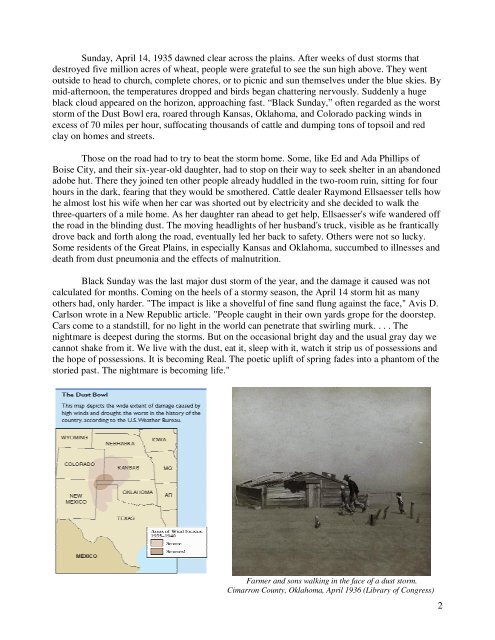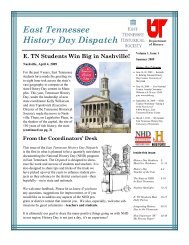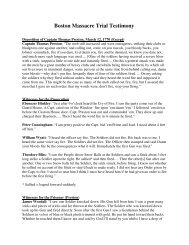“The Dirty Thirties”: The Dust Bowl - Teach American History
“The Dirty Thirties”: The Dust Bowl - Teach American History
“The Dirty Thirties”: The Dust Bowl - Teach American History
You also want an ePaper? Increase the reach of your titles
YUMPU automatically turns print PDFs into web optimized ePapers that Google loves.
Sunday, April 14, 1935 dawned clear across the plains. After weeks of dust storms that<br />
destroyed five million acres of wheat, people were grateful to see the sun high above. <strong>The</strong>y went<br />
outside to head to church, complete chores, or to picnic and sun themselves under the blue skies. By<br />
mid-afternoon, the temperatures dropped and birds began chattering nervously. Suddenly a huge<br />
black cloud appeared on the horizon, approaching fast. “Black Sunday,” often regarded as the worst<br />
storm of the <strong>Dust</strong> <strong>Bowl</strong> era, roared through Kansas, Oklahoma, and Colorado packing winds in<br />
excess of 70 miles per hour, suffocating thousands of cattle and dumping tons of topsoil and red<br />
clay on homes and streets.<br />
Those on the road had to try to beat the storm home. Some, like Ed and Ada Phillips of<br />
Boise City, and their six-year-old daughter, had to stop on their way to seek shelter in an abandoned<br />
adobe hut. <strong>The</strong>re they joined ten other people already huddled in the two-room ruin, sitting for four<br />
hours in the dark, fearing that they would be smothered. Cattle dealer Raymond Ellsaesser tells how<br />
he almost lost his wife when her car was shorted out by electricity and she decided to walk the<br />
three-quarters of a mile home. As her daughter ran ahead to get help, Ellsaesser's wife wandered off<br />
the road in the blinding dust. <strong>The</strong> moving headlights of her husband's truck, visible as he frantically<br />
drove back and forth along the road, eventually led her back to safety. Others were not so lucky.<br />
Some residents of the Great Plains, in especially Kansas and Oklahoma, succumbed to illnesses and<br />
death from dust pneumonia and the effects of malnutrition.<br />
Black Sunday was the last major dust storm of the year, and the damage it caused was not<br />
calculated for months. Coming on the heels of a stormy season, the April 14 storm hit as many<br />
others had, only harder. "<strong>The</strong> impact is like a shovelful of fine sand flung against the face," Avis D.<br />
Carlson wrote in a New Republic article. "People caught in their own yards grope for the doorstep.<br />
Cars come to a standstill, for no light in the world can penetrate that swirling murk. . . . <strong>The</strong><br />
nightmare is deepest during the storms. But on the occasional bright day and the usual gray day we<br />
cannot shake from it. We live with the dust, eat it, sleep with it, watch it strip us of possessions and<br />
the hope of possessions. It is becoming Real. <strong>The</strong> poetic uplift of spring fades into a phantom of the<br />
storied past. <strong>The</strong> nightmare is becoming life."<br />
Farmer and sons walking in the face of a dust storm.<br />
Cimarron County, Oklahoma, April 1936 (Library of Congress)<br />
2






